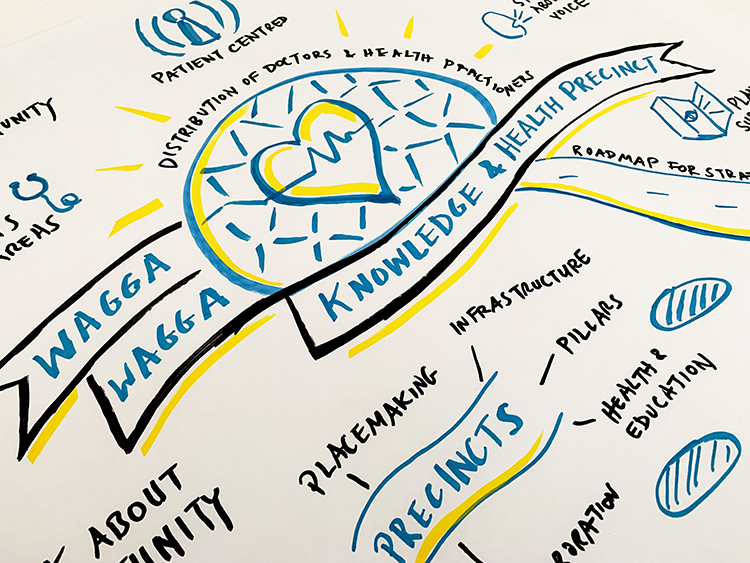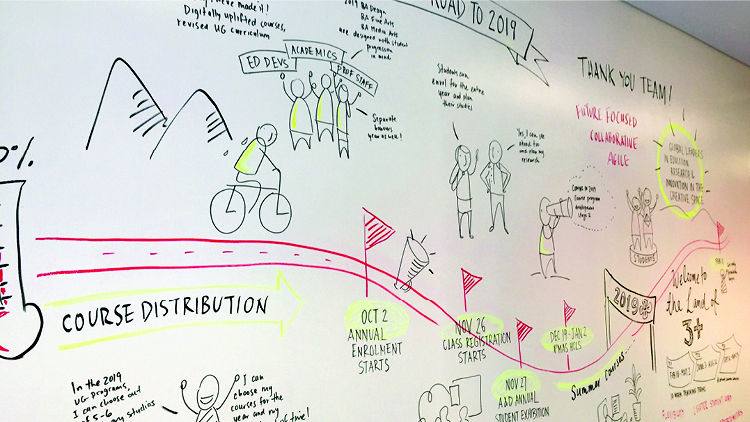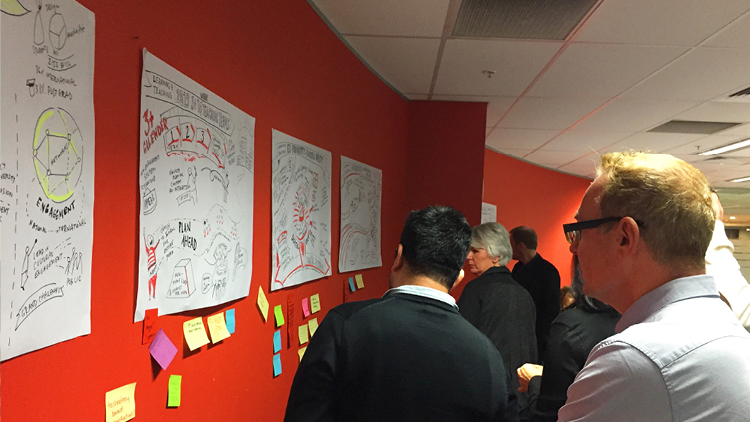Navigating Change through Visual Facilitation


Visual Facilitation is a powerful form of storytelling that can help faciliate large groups to process ideas and moves groups towards a common goal. Dialogue and insights from a workshop, conference or strategy planning meeting are distilled in real-time, using hand-drawn images and words, creating a shared visual memory which endures long after the event. Visual facilitation is effective in bringing clarity around ideas and understanding how they fit into the larger system, process or strategy. Drawing upon symbols and metaphors, they provide an easy recall of concepts.
In Geoff Ball's early paper in the field of graphic facilitation 'Explicit Group Memory', the shared picture supports group learning and leaves a lasting memory in the group. Through making dialogue visible, it acts as a mirror reflecting back the group process using visual representations to help groups digest concepts and navigate change.
Pioneer in the field of visual organisational consulting and author of ‘The Visual Leader’, Dave Sibbert, describes visual thinking as an effective tool for visioning, motivating and facilitating the alignment of teams across an organisation, system thinking and organisational change. It enables people to see things in a comprehensive way, to deal with complexity easily and fosters co-creativity.
In societal transformation work, visual facilitation has been used to summarise complex system ideas, such as in the work of Otto Scharmer’s Theory U. In global environments, visual facilitation speaks across cultural and disciplinary boundaries as well as organisational divisions. Gail Taylor, co-founder of MG Taylor points out that ‘the more diversity in the room, the more powerful visual images become’. Sometimes called visual harvesting, the book ‘Drawn Together through Visual Practice’ compiles experience-based methods and insights from twenty-seven practitioners into visual practice.
Visual facilitation is emergent, it requires listening and involves improvisation. The power is in seeing our thoughts from new perspectives and through the sharing of visual story and interpretation, we find something that resonates with us.

Visual facilitation was utilised for the following workshops and purposes:
UNSW ADA Innovation Hub (2021): UNSW Health Translation Hub Project Brief Workshop. The newly formed UNSW Art, Design and Architecture Faculty comprises of four schools: Arts and Media, Education, Humanities and Languages, and Social Sciences. The faculty established a new ADA Innovation Hub in early 2021 during the Covid pandemic. The hub is a virtual space which brings creative and diverse collaboration projects from the four schools. The UNSW Health Translation Hub Project Brief Workshop was the first project opened to the faculty for collaboration. Outcome: Visualisations aided in communicating ADA Innovation Hub’s objectives and project value proposition, making intangible concepts tangible to Faculty staff and students in a Town Hall Meeting by Dean Claire Annesley.
UNSW Health Precincts (2021): Wagga Wagga Health & Knowledge Precinct Visioning workshop involving key partner organisations and stakeholders within the precinct including hospitals, local health districts, Transport NSW, independent member representatives, university medical education experts to collaboratively bring the vison of the project to fruition. Outcome: Synthesis of key points in response to goals and priorities contributed to by multiple stakeholders.
UNSW Art & Design Transitions Wall Mural (2018): A visual wall mural located in the Art & Design Paddinton Campus’ kitchen visible to both staff and students passing by, was utilised to aid the faculty in a change management initiative to navigate through organisational changes in both pedagogic course development and transitions from a 2 to 3 study term year. Outcome: Communication and capture of the purpose and road ahead in the transition.
UNSW Art & Design, Faculty Strategy Planning Day (2018): to help the faculty move forward into the future with a new 2025 strategy. The visual facilitation aided in creating an interactive and cohesive way to participate in a shared strategic roadmap. Key dialogue was captured and synthesised throughout the day and then reflected back to the group on the wall. The visual canvases captured the shared direction and actions, and the faculty were invited to add their thoughts and reflections to the wall. These were then integrated into the canvases, and later hung in the faculty's communal offices as well as shared through digital media. Various staff members from the executive team, professional staff, academics, researchers, sessional staff to Phd students were able to view the day’s events, a number of whom were not present on the day. Outcome: Greater transparency and improved communication.
‘I pondered the posters for quite a while and I was able to see the multiple layers of discussion that had gone on in that faculty day. For someone like me who’s a student, to see the direction of where the faculty is moving and the sorts of things that are being considered is really important, because it gives me direction as an upcoming academic. I found it really interesting to see it in a visual format, notions were connected and explained, the idea of exploring things visually through text and word. Making those connections visually in a summative way made it easy to understand in brief, rather than having to read a paper about it. I did spend quite a long time reading them.’ – Meg Lomm, Phd Student

